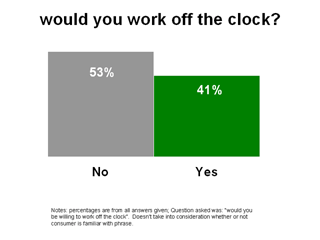research
 |
When I was a minor, I remember training a 24-year old, Ron (1), how to "write tickets", Toys R Us' activity for managing the large toy inventory like bikes, power wheels, strollers, etc. He was to become the "ticket writer" in my absence. We spent at least 2 weeks reviewing everything - customer service protocols, re-stocking procedures, using the computer system, and even assembling and merchandising some of our display areas. Since I was a minor, I had to exit the store by 11pm each night, so for me two weeks totaled about 24 hours. During the holiday season though, a ticket writer can easily work 24 hours in two days, leaving the store at 2 or 3am. Ron, naturally, began feeling as though he was being treated unfairly. A few days before Christmas, he punched out a few minutes after I left, walked right out of the store and went home.
My supervisor, Mike, called me at home to ask me what happened to Ron. I told him I left him in the store working. Mike called his house and found him there, upset that my seniority permitted me to leave whenever I wanted, (according to him) while he had to stay until 2 or 3 am. After Ron's temper tantrum, Mike calmly informed Ron that I was a minor and state law prohibited me from working past 11pm, which is why he was hired, to work when I couldn't. Apparently, Ron, unaware of my age, did not have the words to reply. Mike fired him that evening.
 |
Times have changed and with every new competitive differentiation, it's the frontline associates who must add another duty to execute. This inevitably degrades the quality of the execution of their other duties, while increasing the gap between engaged and disengaged employees.
In a new study published today by al berrios & co., 41% of randomly selected employees across all industries said "Yes" when asked whether or not they'd "work off the clock", while a lower-than-expected 53% said no. Of the 41%, 46.67% said they'd do it because they love their job and 13.33% said they'd do it because they felt a sense of responsibility towards the job. I reckon that this sounds like engaged employees. But how did this happen when employees are apparently overworked at work and feel underappreciated?
Employers have always known that it's not always about the benefits and perks (especially in an economy with more supply than demand.) And yet, the majority of compensation strategy is centered on this thinking. When we broke down the various reasons why workers love or hate their jobs, we clearly see that they don't consciously value benefits, bonuses, and time off as much as their working environment, their relationships with co-workers, the quality of their management, and their employers' professional development opportunities. (Pay, of course, is important.)
In February of 2003, we conducted a qualitative analysis and discovered as much (2). Armed with these behavioral facts about their workers, employers must apply a fresh perspective at how they utilize and compensate their workers.
The problem isn't your employees, it's your policies
|
Related Reports - The Gaping Whole in Your Internal Communications - Being a Great Boss vs Being a Great Leader - Leading & Motivating Your Small Workforce |
This weekend, I visited a Marshall's department store with my family. We stopped off at the lay-away office for one sweater and coat. Although the employees behind the counter, a regular associate and a "merchandising coordinator", appeared to be arguing, it didn't seem like a big deal. After a long 15 minutes, when it came to our turn, the regular associate stared at us for about a minute before asking, "Are you waiting for a lay-away?" While a variety of more colorful responses to that question popped in all our minds, "Yes", sufficed, to which she replied, "Well, she (the customer before us) was my last customer and I'm leaving, so you're going to have to wait for him," pointing at the coordinator.
Not only is this every customer's most dreaded response to a long wait, it just evaporated any patience we may have afforded these overworked associates. The coordinator was oblivious to what had just happened, and unless I asked to be checked out, we may have remained there all day. But how do you request a quick check-out from an angry associate, huffing and puffing away as he prepped dozens of lay-aways, got increasingly irritated with each phone call he answered, and barked "NO!" at customers requesting access to the restroom (because of the high incidence of theft)?
Before checking us out, he had to count-out the register. During check out we asked if everything was OK, to which he replied, "Yeah!". Stunned at his tone, we apologized for assuming. He replied, "Perception kills."
The associate, a mid-thirties woman with a permanent frown and attitude to match, merely watched as she got ready to go on her break. We later learned that she was apparently upset that the company didn't close down and give everyone the day off in observance of Sept. 11, when five Marshall's employees passed away. During her break, she went around the store to discuss her frustrations, including being overworked, to other floor associates.
Had managers been there, these employees would have surely been fired. However, the fault lies with:
1) the overwhelming amount of in-store work each employee is supposed to accomplish during a day while simultaneous helping customers, fixing up displays, and looking out for shoplifters;
2) the low-cost strategy employed by certain retailers who believe their customers don't need help, so they intentionally schedule less associates for any given shift;
3) sub-par internal communications, even by way of morning voicemails or emails, explaining why the store has an obligation to remain open during that day of mourning;
4) poor training, which may have shown these employees how to handle all their duties more efficiently. These employees were probably once excellent, but became poisoned.
What should companies do to make employees happier?
In my 5 years working as a retail associate, I had always attempted to simplify a task not just in language, but by training the new person on less tasks. This assured that the employee would get everything done in a timely manner (so we can all leave the store as quickly as possible), and also make my remaining tasks as a supervisor easier. I've since learned to refine the kinks in this approach and have institutionalized it within my firm: Every job title is responsible for one task. Every level of that job title (i.e. assistant, manager) takes on an additional responsibility up to 3 tasks. Since no task takes more than 5 hours (average per day), associates can leave early. As a result, no employee reaches 40 hours, so no employee gets overworked or bored.
Most beneficial to our cost structure, overtime is avoided and paid time off isn't necessary since everyone is hourly and free to take as much time off as they'd like. This also makes scheduling easier since associates are free to come in anytime they would like as long as there are free work-spaces to work from and they complete their task.
There are also no inefficient uses of time since most of our associates opt to skip their breaks to finish sooner (yes, I frequently remind and encourage breaks). And finally, our culture doesn't require medical benefits as an incentive for an associate to get the job done.
Because the work isn't monotonous and they see their productivity and how it helps the entire firm and its clients, our associates become engaged. Best of all, professional development and career advancement are apparent, making it easier to identify the best of the best for more senior positions.
Despite not having traditional entitlements, everyone repeatedly tells me they love their job, coming in even "off the clock". Consequently, al berrios & co. has never experienced a shortage of qualified and capable associates to execute client engagements and research and by my calculations, we've saved a staggering 60% on payroll costs using this model (compared to the cost of one full-time consultant at standard industry rates, not including benefits); according to Rich Cohen, an employment attorney with Akabas & Cohen who reviewed our employment practices, this model does not violate any New York labor laws (3).
By treating employees as human capital able to perform every additional task given them, service employers are missing the most prominent management strategy in the last century - Six Sigma. By simplifying a job into its basic components, you can identify areas of unnecessary costs, even in a service-based business.
Write to Al Berrios at editor@alberrios.com
1 Names have been changed to protect identities.
2 "Love Your Customers? Then Love Your Service Reps"
3 There are a "myriad" of "arcane rules" in NY State that an employer must adhere (i.e. NY Labor Law requires work breaks and/or lunch breaks of at least 30 minutes if there is a shift of more than six hours which extends over the noon day meal, etc.). As long as they're fulfilled, models like ours are surprisingly legitimate. I strongly recommend interested employers consult an attorney prior to making any modifications to their own organizational design. For more information, visit http://www.akabascohen.com
Disclaimer:
The recommendations, commentary and opinions published herein are based on
public information sometimes referenced via hyperlinks. Any similarities or
likeness to any ideas or commentary from any other sources not referenced
is purely coincidental. al berrios & co. cannot control any results occurring
from advice obtained from this publication nor any opinion(s) conveyed by
any reader of this publication.
al berrios & co. does and seeks to do business with companies covered
in its research reports and studies. As a result, the reader should be aware
that the firm may have a conflict of interest that could affect the objectivity
of this report or study. Readers should consider this report or study as only
a single factor in making any strategic or investment decisions.
(c) 2001-2005. All Rights Reserved. al berrios & company, inc. Published by al berrios & co. This Report may not be reproduced or redistributed in any form without written permission from al berrios & co., subject to penalty.